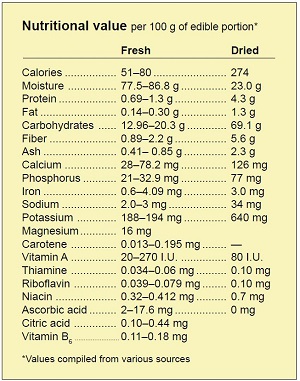From the Twelve
Fruits With Potential Value-Added and Culinary Uses
by Ken Love, Richard Bowen, and Kent Fleming
Fig
Scientific name: Ficus
carica L.
Family: Moraceae
Origin: Western Asia and the Mediterranean

Steeped
in the history and ritual of ancient cultures, the fig has endured the
test of time as one of the most universally enjoyed fruits. Fig
remnants were found in archeological excavations dating back to 5000
BC. Cultivation of the fruit was reported first in ancient Rome, where
29 different types of fig were grown. Believed to be indigenous to Asia
Minor, the fig spread beyond the Mediterranean region before recorded
history. It reached as far north as England in the early 1500s, when it
was already reported as being cultivated in China. Hiram Bingham first
reported the fig in Hawai‘i in 1825.
Members of the Moraceae family, figs are cousins to the Artocarpus species
breadfruit and jackfruit.
Cultivars
There
are about 1000 cultivars of fig, which are usually distinguished by
their size, color of the fruit, and shape of the leaves. The National
Clonal Germplasm Repository in Davis, California, has 140 fig
accessions in its collection. In Hawai‘i the most common types
found are ‘Brown Turkey’ and ‘White Kadota’;
some ‘Black Mission’ figs are found at lower elevations.
Environment
Figs
of various types can be cultivated from sea level to over 5000 feet, so
the crop has potential to be grown in most of Hawai‘i’s
microclimates. The plant is tolerant of most soils with good drainage.
It tolerates drought and some soil salinity but not highly acidic soil.
Horticulture The fig tree has numerous spreading branches and contains
a significant amount of latex, which is an irritant and may cause skin
rash. In Hawai‘i the tree grows rapidly and can achieve heights
of 30 feet or more. The fruit of older trees is seldom harvested due to
the height of the branches. These trees can be cut back to within a few
feet above the soil.
In many regions where figs are grown the
trees are pruned severely after harvest. In Hawai‘i, branches can
be cut back to the first node, and new growth will appear within a
month after pruning. Pruning should be done after each harvest. The
tree can be pruned as an espalier or kept very low to the ground. In
Hawai‘i’s lower elevations, with irrigation, fruit forms
continuously throughout the year, and pruning should be frequent, with
the trees shaped to facilitate harvesting. Although not necessary,
irrigation at lower elevations will increase production: a
1⁄2-gallon/hour emitter for 10 minutes a day in the early morning
ensured constant production at a site at 430 feet elevation. At
elevations above 900 feet, the tree usually produces one or two crops
per year. At mid-elevations, 600–900 feet, it will produce two or
more crops per year, while at lower elevations production is continuous.
Pests and
diseases
In
Hawai‘i the most common problem is bird damage. Mylar tape,
Christmas tinsel, and other reflective materials such as aluminum pie
pans or used CDs are all effective in reducing damage. Protective fruit
wrapping as the fig develops is also effective, but increased heat
inside the wrappings can cause the fruit to ripen prematurely. Wrapping
growing figs in newspaper was a common practice in Hawai‘i during
the early 1900s. Figs are a fruit fly host, with ‘Brown
Turkey’ being less susceptible than ‘White Kadota’.
Following the Hawai‘i. Area-Wide Fruit Fly Pest Management
Program recommendations is advisable. The mango flower beetle (Protaetia fusca)
may also feed on ripe figs. Plant disease pathogens that affect fig in
Hawai‘i are Alternaria
tenuis, which appears as brown to black spots on the
fruit, and Aspergillus
sp. (black mold) and Fusarium
sp. (soft rot), which occur especially as postharvest problems.
Food uses and
nutrition
Figs
are high in fiber, which is good for lowering blood pressure and
controlling cholesterol. Being high in fiber, they also give a feeling
of fullness and are good for diets. Figs are a good source of potassium
and vitamin B6.



'Brown Turkey'
Propagation
Although
grafting and air layers work well for some growers, cuttings from 2 to
3 year old wood is the most common way to propagate figs. The cuttings
should be about 1/2 inch in diameter and about a foot long. Older trees
can be top worked with grafts in order to change variety.
Harvesting
and Yield
In
Hawaii fig production depends on elevation and cultivar. At 430-foot
elevation, a Brown Turkey fig tree that covers a 20 x 25 foot area can
produce more than 2000 figs per year. Trees at 1200 feet will produce
about 800 figs per year, usually in autumn. Figs are fragile
and
should be placed in containers at the time of harvest so that they do
not touch each other. Latex from the stem end should not be allowed to
touch the fruit skin, as it will cause discoloration. White Kadota
produced about 1/2 of what Brown Turkey produced at the 12 Trees
Project site.
Postharvest
Quality
Fully
ripe figs are very perishable and should be chilled as soon as possible
after harvest at 30ºF to 32ºF degrees and 90-95%% relative
humidity for optimum storage of about 30 days. Frozen figs
for
processing can be stored for up to a year or more.
Cost of
Production
The
project fig tree produced an annual marketable yield of 788 pounds. The
average market price was $3.30 per pound, and therefore the tree
generated a gross revenue of $2,598.75 for the year. Growing costs
(fertilization, irrigation, pruning and all weed and pest control)
amounted to $58.81, and harvesting costs (picking, packing and delivery
to market) totaled $535.20. (All labor to grow and harvest the figs was
assumed to be paid at an hourly wage rate of $16.00, including
withholding, FICA and benefits.) Thus, the total annual operating
costs, sometimes referred to as “variable costs,” were
$594.01. The gross margin (gross revenue minus all operating costs) was
$2,004.74.
The fig gross margin is the amount of money
available to pay all the ownership costs associated with the fig
enterprise. Ownership costs, sometimes referred to as “fixed
costs,” include the value of land used (rent or rent equivalent
or mortgage and property taxes), the value of the capital investment
(such as the tree establishment cost and buildings and vehicles), the
value of the management, and the value of any unpaid labor. (All paid
labor is already included in the gross margin.) Ownership costs, unlike
operating costs, will vary substantially from farm to farm and will
depend largely on how the farming operation is financed and on
economies of scale. Each grower will have to calculate his total farm
ownership costs and then allocate an appropriate portion of these costs
to each enterprise on the farm. Now the profitability of the fig
enterprise can be determined by subtracting the fig enterprise’s
share of the total ownership costs from the gross margin for figs.
The
cost and return data are what was obtained from the 12 Trees Project
site and other locations. Yields and costs were based on
optimal
growing conditions for one or more trees at various locations;
different results will be obtained under different growing
conditions. The prices used were actually obtained in 2005
and
2006. There is no guarantee that these prices will continue, especially
if production increases significantly. These costs and
returns
are simply a starting point for growers to make their own estimates.
Packaging,
Pricing and Marketing
Figs
in groceries are usually sold in clamshell plastic boxes to prevent
unnecessary handling and damage. Wholesale figs are delivered in single
layer boxes, often separated by type and degree of ripeness. In Hawaii
figs are usually sold by the piece for about 75 cents each wholesale.
Grocery store and farmer’s market prices can range from 75 cents
to $1.50 each. Chefs will ask wholesalers or growers for fully ripe
fruit or about 80% ripe fruit, which are used for poaching or in,
cooked recipes. Figs lend themselves to a wide variety of value added
products.
Fig and feta
gau gee and wontons
Ken Love
Ingredients:
6 ripe ‘Brown Turkey’ figs
4 oz crumbled feta cheese
1 T finely chopped garlic
Fresh ground pepper
1 package wonton wrappers
Wash
and cut off stem end of figs. Put figs, cheese, and garlic into food
processor or blender and pulse slowly. Texture should be slightly lumpy
and not liquid. Season with a pinch of fresh ground pepper.
Spread
about 1 teaspoon of the mixture onto a wonton and fold to desired
shape. Dampen edges of the wonton so it sticks together. Deep-fry
wontons until golden brown. Makes about 50 pieces. You can also add
finely chopped fresh spinach and cooked rice or orzo pasta to the
mixture if desired. You can also steam the wontons or form them into
shumai.
Serve with sweet and sour dipping sauce or spicy chili sauce.
About
the Twelve Fruits With Potential Value-Added and Culinary Uses Project
Back to
Fig Page
|
© 2007, University of Hawai'i
|


